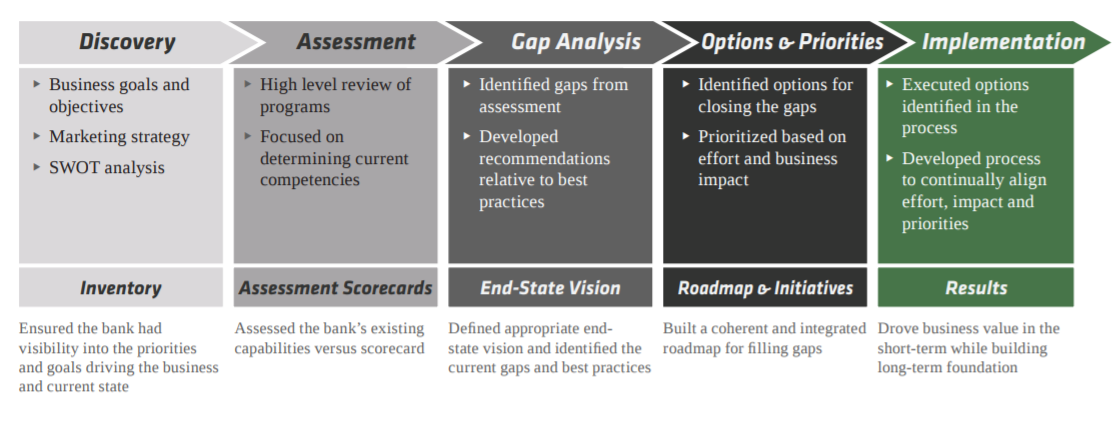5 min read

Why is my business not making money? Why are we not able to grow? What are the problems holding us back?
|
Key Takeaways
|
At some point in time, every business leader has asked themselves these questions. Beyond common challenges of business and economic fluctuations, all businesses at some point reach a plateau and are unsure about where to focus first.
When you're a business leader, you’re expected to solve all of the issues and drive the business forward.
You may need to periodically consider a GAP analysis of your business. A business GAP analysis consists of a more uniform process. This allows you to evaluate your company, where it currently stands, and whether or not it's on track to achieve your business goals from a more objective perspective.
What Is a Business GAP Analysis?
The G, A, and P of "GAP analysis" stand for good, average, and poor, and they're ratings that you can assign to different aspects of your business based on how your business's reality compares to your business goal or ideal vision. [1]
Rather than focusing on the rating, however, a GAP analysis should most importantly help you evaluate your current performance to identify and correct the difference between reality and your ideal vision for your business.
For example, you should compare your business's budget forecasts (ideal, expected, and worst-case scenario) to your actual numbers. Consider how your actual revenue and expenses compare to your expectations, ideal numbers, and worst-possible numbers. You can then address the variance between your actual numbers and your ideal numbers and take action to close the gap.
Source: Merkle Banking And Finance
Sure, sitting down to formally assess your business performance with a GAP analysis might seem like a redundant practice because we naturally make performance judgments and evaluations all the time. However, performing a formal GAP analysis creates a record of performance evaluation while also calling you to take action and aim for improvement.
Why Your Business Should Perform a GAP Analysis
Identify Opportunities for Improvement and Achieve Your Business's Potential
Business leaders should not think of GAP analyses as tools for identifying shortcomings in their companies. Instead, approach the GAP analysis as a tool for identifying opportunities for improvement because an opportunity is truly what a shortcoming is. Every aspect of your business that is currently underperforming presents an opportunity to determine how it can be improved.
The best part? You can use a GAP analysis to evaluate and improve every aspect of your business including:
- Operations
- Services and products
- Pricing
- Clients and customers
- Market share
- Human capital management
- Performance and productivity
- Profit margins
- Cash flow
- Direct and indirect expenses
- Marketing
- Research and development
- Technology and tools
- Investors
Performing a GAP analysis requires you to create an ideal vision of your company, determine how far away from that vision you currently stand, and then adjust your operating framework to orient your entire organization around that vision and begin taking steps toward it. [2]
Read More: Why The Most Successful Businesses Run On Operating Frameworks
Overcome Business Growth Plateaus
From startup to exit, every business goes through various lifecycle stages. During each of these stages, a natural cycle occurs during which there will be periods of growth, stagnation, and even shrinking. These stages of the business cycle are known as expansion, peak, contraction, and trough. As a result of this natural cycle, businesses normally encounter plateaus or periods during which growth stagnates.
Read More: Overcoming Plateaus To Achieve Sustainable Growth
Plateaus can also occur as a result of limitations – whether the business has saturated its current market or the business has expanded to a point at which management's limitations have been met.
Performing a GAP analysis during a growth plateau can help you identify the reason for the plateau and develop a strategy to break free from stagnation and continue expanding.
Sentinel Builders Founder Ryan Jennings ventured off to start his own full-service construction firm in New York City. With no previous accounting background, Jennings quickly found he was in the dark with his numbers more than he thought he'd be.
👉 Read more on how a smart back office has given this business leader peace of mind.
When Your Business Should Perform a GAP Analysis
You can either wait to enter a growth plateau before performing a GAP analysis to evaluate your operations, identify opportunities for improvement, and overcome the stagnation, or...
You can choose to take a proactive approach to business leadership by scheduling regular GAP analyses that occur whether you're stuck in a rut or gliding through a growth stage. These can occur on an annual, bi-annual, or quarterly basis to help you keep an eye on your business goals, operations, and the direction in which your business is moving.
With regular GAP analyses, you can make adjustments to your operations, processes, human capital management, and financial management strategy as you go. This will help you to continue moving in the right direction while avoiding business plateaus altogether.
How to Close the Gap with a Strong Back Office
With a strong back office that's designed to streamline and automate processes, you can easily perform GAP analysis anytime you want. A robust back-office automatically collects your business's financial data, tracks employee time, and translates the data into actionable information.
With a powerful back office, you can track and compare all of your financial metrics with automated reporting, which makes GAP analysis constantly available at the click of a button. So, whether you plan to check in on your company's goal-oriented progress every week or every quarter, you'll have accurate and reliable data to help you stay on course.
With a better back office, you can track a variety of key performance indicators designed to help you stay in control of your business drivers. From human capital management and daily operations to marketing, pricing, and sales, your back office will help you fine-tune your entire business operation and close the gap between where you are and where you want your business to be.
[1] https://www.techrepublic.com/article/how-to-perform-a-gap-analysis-and-why-you-should/






